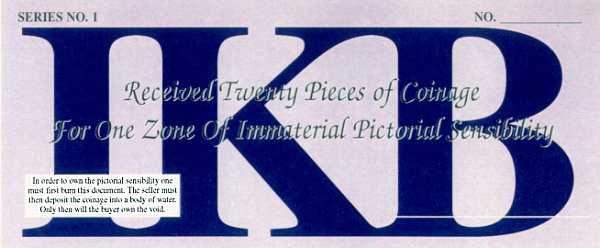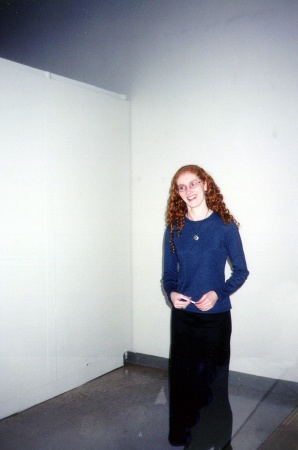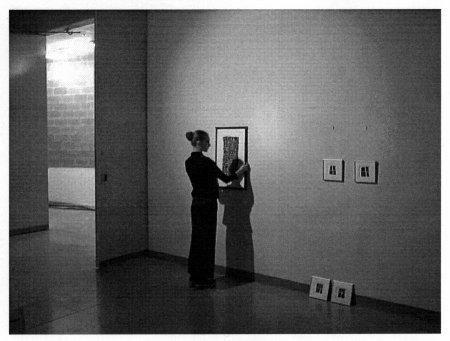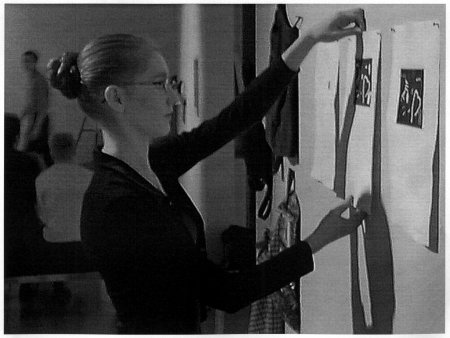| Back to show catalogue | ||
|
Version I Yves Klein's Zones of Immaterial Space: The Questioning of Ownership, Exhibition and Aura - Jennifer Grant Imagine walking into a commercial gallery with the expectation of seeing an exhibition of fine artworks for sale. Perhaps you intend to purchase some works, either to add to your collection, display in your home, or to donate to a museum or gallery. Yet, upon entering the exhibition room, you find that it is empty. The walls are bare and there are no paintings or sculptures to be found. There is nothing visual or material within the space except for the white walls and the people that exist within the space. In your state of confusion, you are informed that there are indeed artworks for sale. The space itself is the art, and for a small amount of gold, you can own a portion of the immaterial space, along with the aura of the artist. For most, this notion would seem ludicrous, for who would wish to purchase something intangible? This is the question that Yves Klein challenged with his Zones of Immaterial Pictorial Sensibility and Le Vide. In these exhibitions, Klein confronted ideas of ownership, exhibition and the aura of the artist. Through the Ritual Rules for the Transfer of Zones of Immaterial Pictorial Space, Yves Klein examined societal notions of ownership and purchase. For the first time in art history, buyers and collectors were expected to buy artwork that was intangible. The art could not be displayed, resold, or even escalate in value. Part of the reason for this is that there was no substantial proof that one owned the work. Klein insisted that in order to own the actual "void," the receipt (the material object which verified the existence of the exchange and the space itself) must be burned. The gold used for the purchase was then tossed into the Seine river as a means of solidifying the "contract." The use of gold for the purchase was an extremely significant idea. Unlike daily practices of purchasing and selling where paper currency is exchanged for a product, the product, (the gold) was now exchanged for paper, (the receipt). The daily event of exchange became transformed into a ritual-like performance that challenged notions of purchase and ownership.(1) In the end, the buyer owned nothing but the immaterial, intangible idea of the artist without having anything to prove that the actual event took place (with the exception of the ashes of the burnt receipt). It was the ritual that remained important, not the "artwork," or the owning of the "void." Le Vide, the earliest exhibition of the void, questioned ownership as well. Klein believed himself to be the creator of the void, and therefore, had ownership and authorship over the entire space. He claimed that during the exhibition, ". . . one [found] oneself being literally impregnated by the sensible pictorial state that was specialized and stabilized by the painter before hand in the given space."(2) By this Klein affirms his direct ownership and creation of the pictorial sensibility before the exhibition took place. The pictorial sensibility was created by Klein (the painter), and then injected into the gallery. Just as any artist believes to have originally "owned" their artworks prior to the selling of them, Klein believed that the void belonged to him. Just as he had signed the sky, claimed ownership over "International Klein Blue," and considered fire, air and water to be tools for the creation of his art, Le Vide is another example of where Klein examined notions of ownership over something very broad and universal. As Buchloh suggests, "The dubious distinction of having claimed a natural phenomenon . . . as private property, a brand name, and of legalizing this preposterous pretense by a signature or by the quest for a patent, is Yves Klein's."(3) Furthering this notion of ownership is the fact that Klein charged admission to Le Vide for those who were not initially invited. He believed that by merely precessing through the gallery, one absorbed the immateriality of the space and, at the same time, injected their presence into the void. By doing such, the viewer changed the space, and claimed ownership over some part of it.(4) This can be seen as a critique on the purchasing of art. Once someone buys a work of art, it is immediately taken out of its context of creation (the studio, the gallery etc.) and may enter into an entirely different realm (such as a household) where its original meaning is silenced. In the process of this silencing, the work is then linked to other associations which may or not be coherent with the artist's intent.
Yet, aside from the exhibiting of an empty gallery, Klein also exhibits the main focus of his art. Christopher Phillips, a writer for Art in America believes that the Void Room "[enabled] viewers to experience at its fullest the 'heightened sensibility' to . . . space that Klein meant all of his works to induce"(5) Works such as the Blue Monochromes, Air Sculptures, and Leap into the Void, are all central to Klein's concept of space and sensibility. The Blue Monochromes were meant to illustrate the expansive, immaterial pictorial space by their effects on viewer perception.(6) With his Air Sculptures, Klein believed that he could manipulate an intangible natural phenomenon in order to create a visual and material display. Finally, with Leap into the Void, (which occurred after the "Void" exhibitions) Klein proposed that one could defy space and become one with it.(7) Therefore, it is pictorial space as well as the construction and defiance of material space, that is being exhibited, rather than a material object. Tying into Klein's questioning of ownership and exhibition, is the idea of aura. In Zones of Immaterial Pictorial Sensibility, it is the aura of Klein which is being sold and exhibited, rather than a painting, drawing or sculpture. As mentioned earlier, Klein believed himself to be the owner and creator of the void. This concept is linked to the idea that Klein had "impregnated" the space with his aura.(8) In this reference, the aura can be considered the subconscious presence of the artist through his or her creation of the work of art. Connoisseurship and even the practices of collecting and dealing are based upon the notion of the aura. Somewhere in the work of art, there is a glimmer of the artist. The aura may be linked to the style, the paint application, or the specific manipulation of the medium by the hand of the artist. For the buyer, there is the belief that they are purchasing something of the artist, or perhaps a piece of the artist themselves. This mystical and almost fantastical idea is being examined in the Zones of Immaterial Pictorial Sensibility.
Yet, unlike paintings and sculptures which may contain aura through style, Klein presents no material object to attribute a "style" to. Instead, he presents just the aura: the presence of himself and pictorial sensibility. There is the expectation that the public will purchase the immateriality because it contains this mystical presence. And why not? Tangible works of art were sold merely on the existence of the aura of the artist. This is the reason why originals are worth far greater than forgeries, and why attribution is so important in modern society. Klein pushes this idea and the belief in the aura further by presenting the artist without the work. In his exhibition L'epoca Blu, Klein priced several identical blue monochromes at different prices. Each painting was sold for the price indicated, which to Klein's enjoyment, added to his idea that value was not solely limited to the visual, but to what one attributes to it.(11)
Footnotes 1. Thierry
De Duve, "Yves Klein, or The Dead Dealer," October 49.3 (1989):
89.
Works Cited Buchloh, Benjamin H. D. "Out of the Blue: Klein and Poses." Art Forum 33.10 (1995): 92-97 De Duve, Thierry. "Yves Klein, or The Dead Dealer." October 49.3 (1989): 73-90. Phillips, Christopher. "All About Yves: A wide-ranging Yves Klein retrospective demonstrates the variety of the artist's paintings and sculptural objects, and attempts to re-create the ambience of Klein's gallery installations." Art in America 83.5 (1995): 86-91. Rosenthal, Nan. "Out of the Blue: Comic Relief." Art Forum 33.10 (1995): 92-97 Stitch, Sidra. Yves Klein.
Stuttgart: Cantz Verlag, 1994.
". . . one [found] oneself
being literally impregnated by the sensible pictorial state that was specialized
and stabilized by the painter before hand in the given space."(2)
"The dubious distinction
of having claimed a natural phenomenon . . . as private property, a brand
name, and of legalizing this preposterous pretense by a signature or by
the quest for a patent, is Yves Klein's."(3)
"[enabled] viewers to experience
at its fullest the 'heightened sensibility' to . . . space that Klein meant
all of his works to induce"(5)
.
"time and space."(9)
" . . . originated in the service of a ritual - first the magical . . .
[and] that the existence of the work of art with reference to its aura
is never entirely separated from its ritual function." (10)
Footnotes 1. Thierry
De Duve, "Yves Klein, or The Dead Dealer," October 49.3 (1989):
89.
Works Cited Benjamin, Walter. "The Work of Art in the Age of Mechanical Reproduction." Art in Theory: 1900 - 1990. An Anthology of Changing Ideas. Cambridge, Blackwell Publishers Ltd., 1996. Buchloh, Benjamin H. D. "Out of the Blue: Klein and Poses." Art Forum 33.10 (1995): 92-97 De Duve, Thierry. "Yves Klein, or The Dead Dealer." October 49.3 (1989): 73-90. Phillips, Christopher. "All About Yves: A wide-ranging Yves Klein retrospective demonstrates the variety of the artist's paintings and sculptural objects, and attempts to re-create the ambience of Klein's gallery installations." Art in America 83.5 (1995): 86-91. Rosenthal, Nan. "Out of the Blue: Comic Relief." Art Forum 33.10 (1995): 92-97 Stitch, Sidra. Yves Klein. Stuttgart: Cantz Verlag, 1994. |
||

 With
shows such as Le Vide and Zones of Immaterial Pictorial Sensibility,
Klein not only dealt with the issue of ownership, he also critiqued the
process of exhibition. As with any exhibition of art, there is something
that the artist presents for the viewer to encounter. Usually, the encounter
includes a physical object or a collection of them, be it painting, sculpture,
installation or performance. Yet, in essence, although there is some physicality
involved in an exhibition, the basic element that is displayed is the idea.
The idea may take the form of an artist's intentions, it may present a
societal focus, or it may possibly create a space for personal reflection
and inward questioning. In Zones of Immaterial Pictorial Sensibility,
Klein presents only the idea, and the object that creates the dialogue
between the viewer and the exhibit is removed (i.e. the painting or sculpture).
Instead, one must interact with the void and recognize that the elimination
of objects is the thing that is on display.
With
shows such as Le Vide and Zones of Immaterial Pictorial Sensibility,
Klein not only dealt with the issue of ownership, he also critiqued the
process of exhibition. As with any exhibition of art, there is something
that the artist presents for the viewer to encounter. Usually, the encounter
includes a physical object or a collection of them, be it painting, sculpture,
installation or performance. Yet, in essence, although there is some physicality
involved in an exhibition, the basic element that is displayed is the idea.
The idea may take the form of an artist's intentions, it may present a
societal focus, or it may possibly create a space for personal reflection
and inward questioning. In Zones of Immaterial Pictorial Sensibility,
Klein presents only the idea, and the object that creates the dialogue
between the viewer and the exhibit is removed (i.e. the painting or sculpture).
Instead, one must interact with the void and recognize that the elimination
of objects is the thing that is on display.
 The
aura was a central idea in terms of modern art, and also an idea that was
challenged by many art theorists. Walter Benjamin wrote quite extensively
on the notion of "aura." He believed that the aura of art works was eliminated
with the dawning of technological advancements, namely reproduction. Only
a true work of art could exist within "time and space."
The
aura was a central idea in terms of modern art, and also an idea that was
challenged by many art theorists. Walter Benjamin wrote quite extensively
on the notion of "aura." He believed that the aura of art works was eliminated
with the dawning of technological advancements, namely reproduction. Only
a true work of art could exist within "time and space." In
conclusion, for the upcoming exhibition entitled, The Klein Mystery,
I wish to present, as accurately as possible, the above concepts that are
linked to the Void Room. My representation of the Zones of Immaterial
Pictorial Sensibility will contain the ritual aspects of purchasing
that were outlined with the
Ritual Rules for the Transfer of Zones of
Immaterial Pictorial Space. In addition, I will be sure to exhibit
only space and sensibility. Like Klein, I will attempt to create the pictorial
space before the exhibition, and then inject it into the gallery (although
I am sure I can not do this in quite the same manner as Klein). What I
am afraid I cannot do, is recreate the aura. For the aura is Klein's and
Klein's alone, and his mystical presence cannot be created, it can only
be copied.
In
conclusion, for the upcoming exhibition entitled, The Klein Mystery,
I wish to present, as accurately as possible, the above concepts that are
linked to the Void Room. My representation of the Zones of Immaterial
Pictorial Sensibility will contain the ritual aspects of purchasing
that were outlined with the
Ritual Rules for the Transfer of Zones of
Immaterial Pictorial Space. In addition, I will be sure to exhibit
only space and sensibility. Like Klein, I will attempt to create the pictorial
space before the exhibition, and then inject it into the gallery (although
I am sure I can not do this in quite the same manner as Klein). What I
am afraid I cannot do, is recreate the aura. For the aura is Klein's and
Klein's alone, and his mystical presence cannot be created, it can only
be copied.